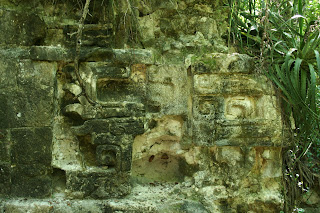I rode the highway west stopping along the way at a roadsite ruin Manos Rojas. There are a few structures here, all badly ruined, but I just stepped off the highway and walked about 50 feet to a single Rio Bec style structure. Only a few incomplete masks left, but from the fallen stones, this building must have been very ornate with a monstermask doorway.
 The best remaining mask, one of a stack of masks very much like ones seen far to the north at the Chenes site Xichmook.
The best remaining mask, one of a stack of masks very much like ones seen far to the north at the Chenes site Xichmook. This stone was most likey a huge nose the was over the central doorway which proabably had a monstermouth doorway.
This stone was most likey a huge nose the was over the central doorway which proabably had a monstermouth doorway.
The next stop was the ruins of Balamku. Balamku is a Peten style site with Rio Bec style appearing only at the very end. It seemed to me there was much Rio Bec influence in the early buildings, but rescent work has classified this as a Peten site because the ceramic material is consistent with Peten style sites, not with Rio Bec sites. Balamku is a moderate sized site, with three groups of monumental structures, two which are open to the public.

A Late Preclassic-Early Classic temple. In this structure was found the earliest monstermouth doorway, a hallmark of the Rio Bec-Chenes style. This building however is consitered pure Peten style. The remains of the mostermouth doorway are either rebuiried or gone.

The temple at the summit. Unlike Rio Bec architecture because of the rough, nearly unworked stones used and the simple design, no fancy moldings. This structure is well preserved because it was buired by a later construction, much of the later pyrimid is still in place as can be seen at the right. The cut though the center, as I understand is not because the structure collapsed, but becuase looters cut though it.

The inside of the temple showing the crude masory typical of early Peten structures, and very much unlike Rio Bec stuctures.
This is an increadible palace unlike others I have seen. The masonry is in the classic Rio Bec style, but the right and left wings of the palace are done in two different styles. One side is typical Rio Bec (with the false door and curved platform on the right), but the left side is plain, with a Puuc like molding on the platform (but the Puuc almost always used plain platforms with no moldings).
 The Rio Bec wing of the palace with a the remains of a 'twin tower' style temple.
The Rio Bec wing of the palace with a the remains of a 'twin tower' style temple.
The famous frieze uncovered by looters and was found before it was removed. It is hard to believe, but a freize like this turned up in New York City on the black market. It originated from a ruin about 50km south of Xuphil. Looters were able to remove it, pack it and get it all the way to New York. A researcher was approach in an atempt to find a buy and an he turned them in. The freeze is now in the Mexico City museum. This is the upper part of the building, and a door can be seen below.

The masks uncovered at Ek Balam look very much like this, and is probably a good representation of Rio Bec style masks, however this example is probably from the late Early Classic, before the Rio Bec style was formalized. While the masks look mostly red, there is much fine details of paint still visable.

This type of imagry appeared on ceramics around 550AD.

The campsite, I rented the tent.
Distance rode: 73km
Total: 1544km
 The best remaining mask, one of a stack of masks very much like ones seen far to the north at the Chenes site Xichmook.
The best remaining mask, one of a stack of masks very much like ones seen far to the north at the Chenes site Xichmook.



 The Rio Bec wing of the palace with a the remains of a 'twin tower' style temple.
The Rio Bec wing of the palace with a the remains of a 'twin tower' style temple.




No comments:
Post a Comment